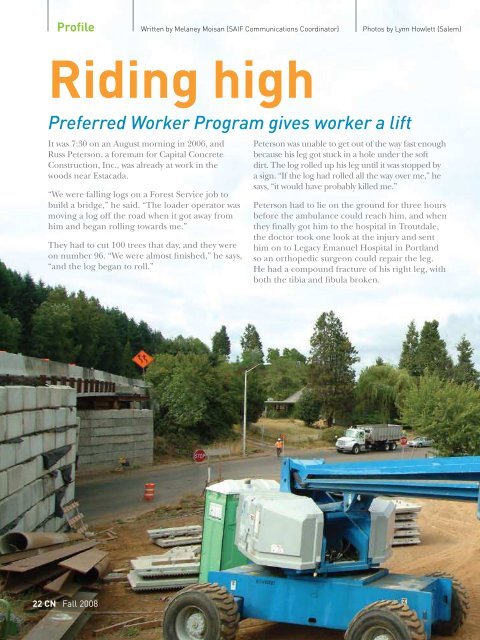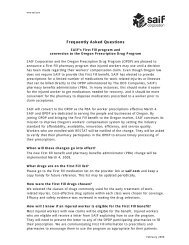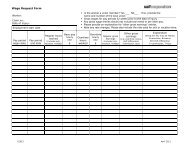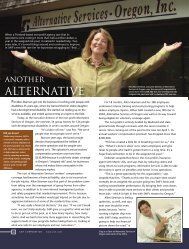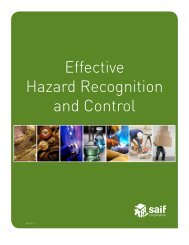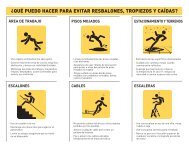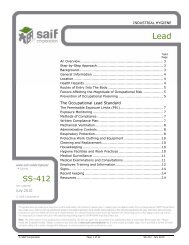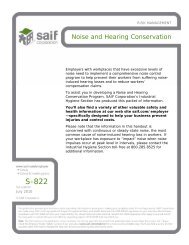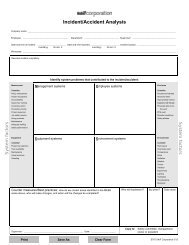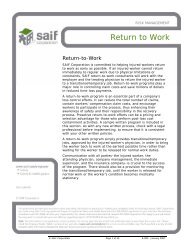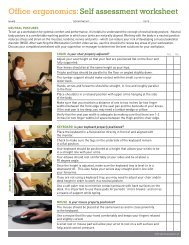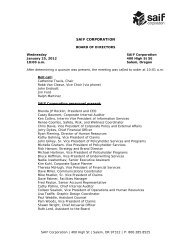pg. 6 - SAIF Corporation
pg. 6 - SAIF Corporation
pg. 6 - SAIF Corporation
You also want an ePaper? Increase the reach of your titles
YUMPU automatically turns print PDFs into web optimized ePapers that Google loves.
Profile Written by Melaney Moisan {<strong>SAIF</strong> Communications Coordinator} Photos by Lynn Howlett {Salem}<br />
Riding high<br />
Preferred Worker Program gives worker a lift<br />
It was 7:30 on an August morning in 2006, and<br />
Russ Peterson, a foreman for Capital Concrete<br />
Construction, Inc., was already at work in the<br />
woods near Estacada.<br />
“We were falling logs on a Forest Service job to<br />
build a bridge,” he said. “The loader operator was<br />
moving a log off the road when it got away from<br />
him and began rolling towards me.”<br />
They had to cut 100 trees that day, and they were<br />
on number 96. “We were almost finished,” he says,<br />
“and the log began to roll.”<br />
Peterson was unable to get out of the way fast enough<br />
because his leg got stuck in a hole under the soft<br />
dirt. The log rolled up his leg until it was stopped by<br />
a sign. “If the log had rolled all the way over me,” he<br />
says, “it would have probably killed me.”<br />
Peterson had to lie on the ground for three hours<br />
before the ambulance could reach him, and when<br />
they finally got him to the hospital in Troutdale,<br />
the doctor took one look at the injury and sent<br />
him on to Legacy Emanuel Hospital in Portland<br />
so an orthopedic surgeon could repair the leg.<br />
He had a compound fracture of his right leg, with<br />
both the tibia and fibula broken.<br />
Seven hours after the accident, Peterson was<br />
finally headed for surgery. His first surgery lasted<br />
more than three hours, and a second one two<br />
days later took more than two hours. Doctors<br />
placed a titanium rod in the tibia with pins in his<br />
ankle and knee.<br />
Peterson began physical therapy and was released<br />
to modified work in the fall. His employer had him<br />
doing computer work in the office, but Peterson<br />
was eager to get back to his regular duties.<br />
“He asked me if I wanted to stay in the office,” says<br />
Peterson, “but I said no. It’s fine in the winter, but<br />
in the summer, I want to be outside.”<br />
Through the Preferred Worker Program, the<br />
employer was able to purchase a cherry picker<br />
aerial work platform that helped Peterson<br />
return to his work as foreman. In addition to<br />
providing more than $24,000 for the lift, the<br />
Preferred Worker Program (funded through the<br />
Workers’ Compensation Division) will also give<br />
the employer a wage subsidy equal to 50 percent<br />
of Peterson’s wages for six months and premium<br />
relief for this worker for three years.<br />
“He still has some limitations,” says Ken Garcia,<br />
owner of Capital Concrete. “For example, he can’t<br />
climb ladders. The lift works real well for him in<br />
situations like that. I’m just glad to get him back<br />
on the job.”<br />
22 CN Fall 2008 Fall 2008 CN 23


